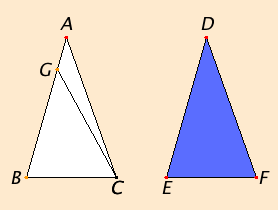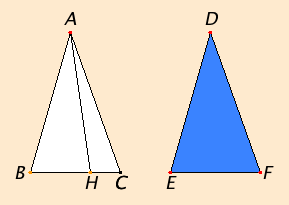Proposition 26
Let ABC and DEF be two triangles having the two angles ABC and BCA equal to the two angles DEF and EFD respectively, namely the angle ABC to the angle DEF, and the angle BCA to the angle EFD, and let them also have one side equal to one side, first that adjoining the equal angles, namely BC equal to EF.
I say that the remaining sides equal the remaining sides respectively, namely AB equals DE and AC equals DF, and the remaining angle equals the remaining angle, namely the angle BAC equals the angle EDF.

If AB does not equal DE, then one of them is greater.
Let AB be greater. Make BG equal to DE, and join GC.
Since BG equals DE, and BC equals EF, the two sides GB and BC equal the two sides DE and EF respectively, and the angle GBC equals the angle DEF, therefore the base GC equals the base DF, the triangle GBC equals the triangle DEF, and the remaining angles equal the remaining angles, namely those opposite the equal sides. Therefore the angle GCB equals the angle DFE. But the angle DFE equals the angle ACB by hypothesis. Therefore the angle BCG equals the angle BCA, the less equals the greater, which is impossible.
Therefore AB is not unequal to DE, and therefore equals it.
But BC also equals EF. Therefore the two sides AB and BC equal the two sides DE and EF respectively, and the angle ABC equals the angle DEF. Therefore the base AC equals the base DF, and the remaining angle BAC equals the remaining angle EDF.
Next, let sides opposite equal angles be equal, as AB equals DE.
I say again that the remaining sides equal the remaining sides, namely AC equals DF and BC equals EF, and further the remaining angle BAC equals the remaining angle EDF.
If BC is unequal to EF, then one of them is greater.

Let BC be greater, if possible. Make BH equal to EF, and join AH.
Since BH equals EF, and AB equals DE, the two sides AB and BH equal the two sides DE and EF respectively, and they contain equal angles, therefore the base AH equals the base DF, the triangle ABH equals the triangle DEF, and the remaining angles equal the remaining angles, namely those opposite the equal sides. Therefore the angle BHA equals the angle EFD.
But the angle EFD equals the angle BCA, therefore, in the triangle AHC, the exterior angle BHA equals the interior and opposite angle BCA, which is impossible.
Therefore BC is not unequal to EF, and therefore equals it.
But AB also equals DE. Therefore the two sides AB and BC equal the two sides DE and EF respectively, and they contain equal angles. Therefore the base AC equals the base DF, the triangle ABC equals the triangle DEF, and the remaining angle BAC equals the remaining angle EDF.
Therefore if two triangles have two angles equal to two angles respectively, and one side equal to one side, namely, either the side adjoining the equal angles, or that opposite one of the equal angles, then the remaining sides equal the remaining sides and the remaining angle equals the remaining angle.